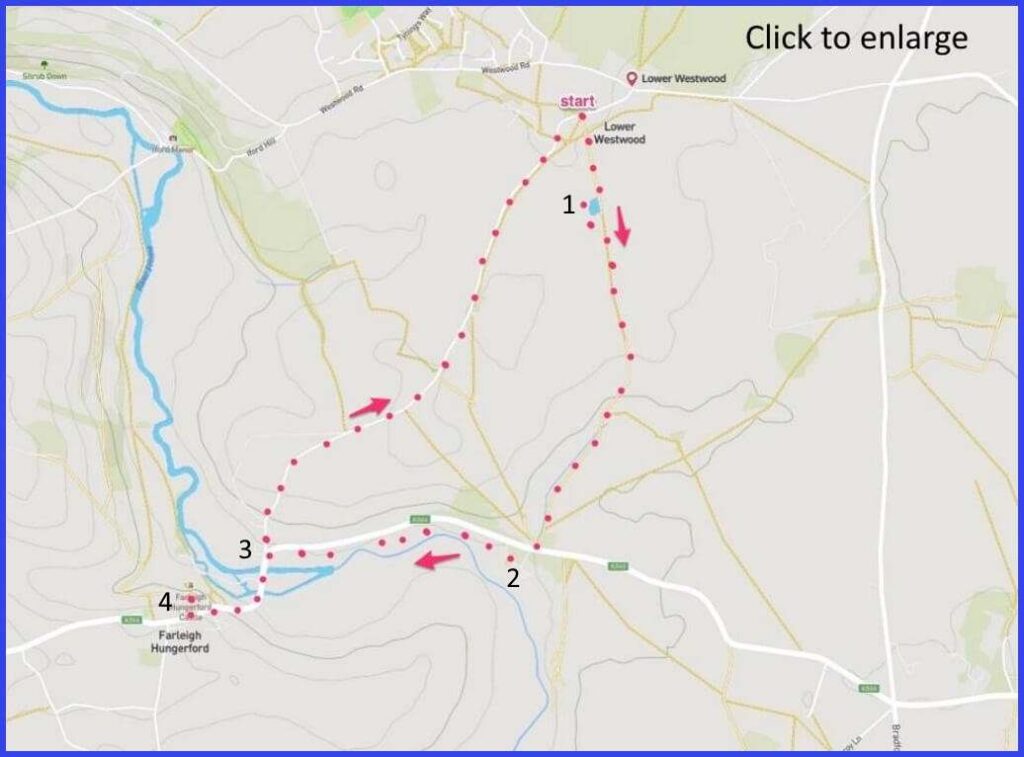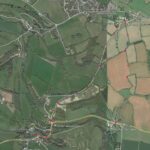(Routes suggested from each map point + metres to next point)
Start: The postcode is for St Mary’s Church [A]. Slightly beyond its entrance is a two bar stile-to-footpath (closeup map here). Head across this field towards the small pond of water marked on the map (but it may be dried out. 200m
1: Walk around it to the left and continue to follow the path through successive fields until reaching the A336 at a farm. 1.1km
2: Across the road and to the right is the entrance to Stowford Manor camping park. Its not marked as a footpath but you can walk through here – passing the Farlieigh and District outdoor swimming club on the left. 800m
3: Where you cross a stile onto the road. Perhaps electing to read rightwards towards Hungerford castle. 400m
4 Retrace your steps and before the bend at 3 walk up the hill in front of you, returning to start (closeup map here). 2km
The pictures below are in the order things were seen on this walk. Clicking on any one will enlarge it (and the slideshow)
The walk
There is parking near Westwood Manor. The route starts out across field paths. Shortly there is pond marked on the map but it seems now to be a copse of trees. Bypass it. The route across these fields towards the main road is not obviously marked, but its legitimate. Just head south generally hugging the field boundaries while veering right towards the end. At point 2 on the route map you meet Stowford farm. This is a centre that runs rural courses for families – with camping facilities. As you walk in a rightwards direction (and parallel to the road) you will shortly pass the area of the Farleigh and District Swimming club. Some of whom may be swimming about in the River Frome. A detour to Farleigh Hungerford castle is recommended despite a short stretch of A366 to get there. Then return north to Westwood via a pleasant (but uphill) lane.
Westwood
The walk starts at St Mary the Virgin church. It’s worth a visit – Pevsner notes the “splendid perpendicular west tower”, which he declares to be “the best in the county perhaps”. The chancel window has some good 15th century stained glass. There is a grotesque 16th century beast carved over the font – maybe not a suitable sight for a baptism. But painting and carving was supposed to tell stories to congregations – and many good stories had a place for evil spirits.
In Norman times, Westwood was one of the estates assigned for supporting the monks at Winchester Cathedral. More recently it is known for the more secular work of its quarries (in the upper part of the village – i.e. on the other side of the church and to its right). These were active from the mid seventeenth century until recently – originally contributing much stone to the housing at Bath via the nearby railway at Avoncliff. But the quarries have been used for more exotic purposes in recent times (see below).
Nearby is Westwood Manor. Which Pevsner describes as “a perfect English manor house”. It dates from 1400 and is known for its collection of furniture and musical instruments. These were assembled between 1911-1956 by the then owner Edgar Lister, a diplomat at the Ottoman court. Its owned by English Heritage and so can be visited if you want a slight walking detour (well worth it).
The Hungerfords
On reaching the road beyond these fields, a visit to Farleigh Hungerford castle is suggested. There is an admission charge – although it does come with a free audio guide. This can make a big difference, as the castle is a restored ruin that is hard to interpret even though the place does have a number of interesting stories attached to it. The earliest part dates from the 1370s with a later expansion from the time of Henry Vth. The castle was owned by the Hungerford family up until 1730. The Hungerfords are important to Wiltshire. They had been central to the development of the successful wool trade in the county across from the 13th century and onwards. In later years, Sir Edward Hungerford was leader of the Wiltshire Roundheads (albeit a rather incompetent leader). In the end the family’s extravagance brought about their downfall and this castle was purchased by Trowbridge clothiers. Sadly, it later fell to ruin.
At the end of your walk you might fancy the New Inn at the crossroads down towards the end of the road on which you started. It’s a pleasant place, with some outdoor seating and a standard pub menu. Or if the church hall is open you might find a typical English afternoon tea being served (picture H).
Quarries
A particularly interesting feature of Westwood is an area not strictly covered by this walk – although it’s only slightly to the north, behind the Church grounds. If you wander that way you will find signs of Westwood quarries – tunnels, eight feet high and twelve feet wide. After their quarrying service ended here they were turned to many unusual roles. They housed a mushroom farm, a collection of national art treasures, Royal Enfield manufacturing of gunshot (later, the servicing of motorbikes), and (most bizarre of all) a testing facility for microbiological warfare emergencies. During the second world war these tunnels gave protection to national works of art: including exhibits from the British Museum, pictures from the National Portrait Gallery, tapestries from the Victoria and Albert and even the Elgin Marbles. An air conditioning plant was installed to control humidity – the whole repository was protected against damaging damp.
After the World War the quarries were implicated in the Cold War. They were occupied by Porton Down scientists in the 1950s who carried out microbiological warfare research, as explained more fully in this article and video. This was a re-purposing that led to some concerns about knock on effects of exposure to residue that might occur for other groups that used the tunnels – e.g. the Royal Enfield workers. This secret work anticipated the danger of a terrorist release of clouds of deadly organisms as they might be sprayed in a tunnel area such as the London underground. All together, a village with an interesting personality.



![[A]](https://wiltshirewalks.com/wp-content/uploads/2021/10/01westw-150x150.jpg)
![[B]](https://wiltshirewalks.com/wp-content/uploads/2021/10/02westw-150x150.jpg)
![[C]](https://wiltshirewalks.com/wp-content/uploads/2021/10/03westw-150x150.jpg)
![[D]](https://wiltshirewalks.com/wp-content/uploads/2021/10/04westw-150x150.jpg)
![[E]](https://wiltshirewalks.com/wp-content/uploads/2021/10/05westw-150x150.jpg)
![[F]](https://wiltshirewalks.com/wp-content/uploads/2021/10/06westw-150x150.jpg)
![[G]](https://wiltshirewalks.com/wp-content/uploads/2021/10/07westw-150x150.jpg)
![[H]](https://wiltshirewalks.com/wp-content/uploads/2021/10/08west2-150x150.jpg)
![[I]](https://wiltshirewalks.com/wp-content/uploads/2021/10/09westw-150x150.jpg)
![[J]](https://wiltshirewalks.com/wp-content/uploads/2021/10/10westw-150x150.jpg)